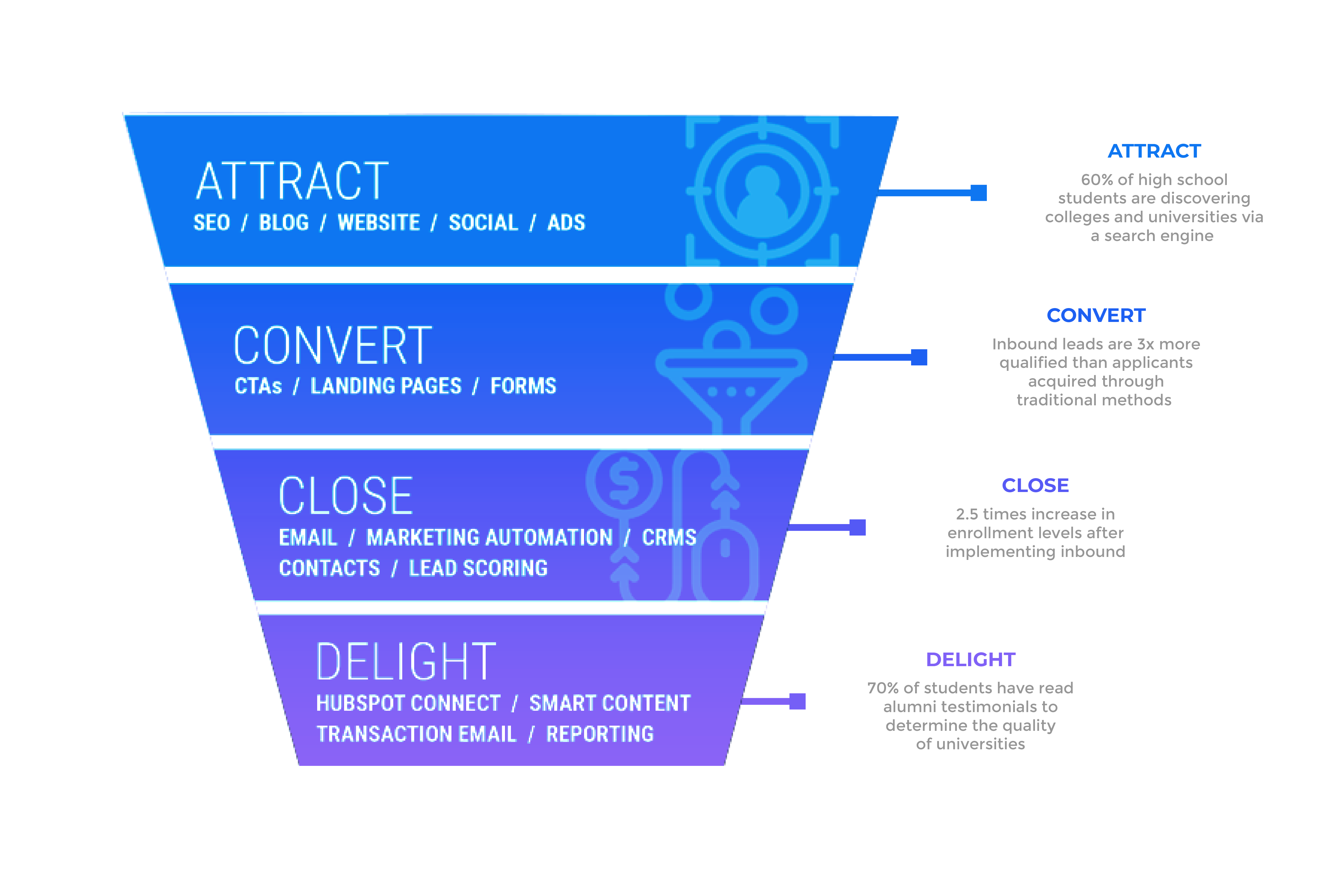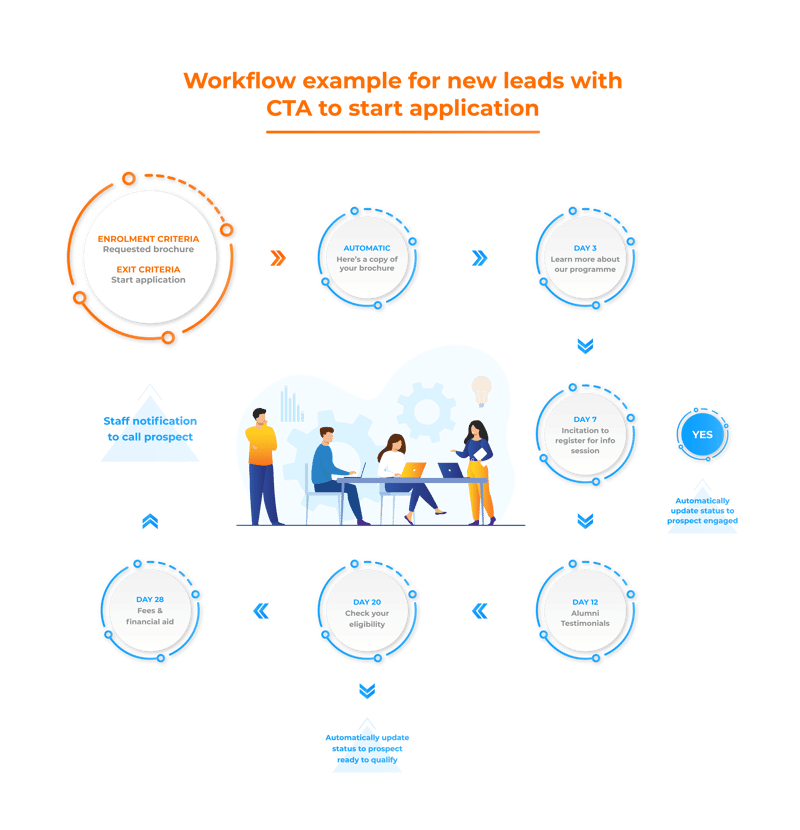How to Increase Enrollment through Inbound Marketing

Student recruitment has become increasingly complex in today’s crowded and competitive education sector. The direct, outbound marketing strategies that once worked just aren’t delivering results anymore.
In order to meet and surpass your recruitment goals and to find students who are the right fit for your Educational Institution, you have to invest in the best techniques. First you need to understand the differences between the inbound and outbound approaches, so you can take the right path for your institution.
Outbound involves proactively reaching out to students to get them interested in your institution. Content is displayed in, print ads, billboards, telemarketing, TV and Radio ads. On the other hand, Inbound focuses on creating and distributing content that draws students into your institution. Content comes in interactive forms, such as social media posts, blogs, emails, webinars.
Inbound Enrollment is based on the inbound marketing methodology. However it offers to Educational Institutions so much more as it is designed specifically for the education sector and focuses on the students’ enrollment funnel.
Inbound Enrollment
Inbound Enrollment is an approach for Educational Institutions (Universities, Schools and Education management centers) to integrate the marketing and admission processes. As a result, allowing them to meet their goals by building meaningful, lasting relationships with prospective students or parents.
Inbound Enrollment includes strategies that attract the right students, convert them into known contacts, and engage with them at key moments in their journey so that they take that next step to learn more about your institution and ultimately apply.
Before starting to engage with prospective students you need to understand the student journey. The student Journey consists of three stages; awareness, consideration and decision.
In the awareness stage, prospective students are researching their learning options and getting to know different institutions, universities and programs. Then in the consideration stage, prospective students have recognized their unique needs and may know what type of program is the best fit for them. The final stage of the student’s journey is the decision (or enrollment) stage; they have determined their options in the consideration stage and they are looking for information on why they should choose your institution.
Here are some of the most asked questions in each stage:

Inbound Enrollment helps in breaking down the barriers between the admission team and the marketing team. The data gathered through the admission system will be analyzed to begin to identify user behavior which will help the marketing team in personalizing the experience for applicants in each stage.
Inbound Marketing
Inbound marketing is a methodology that attracts prospective students by creating valuable content and experiences specifically designed for them. In simple terms it is the method of growing your higher education institution(HEI) by building meaningful, lasting relationships with prospective students, parents or staff. Inbound marketing is a strategy that utilizes many forms of pull marketing such as; content marketing, blogs, email marketing, event marketing, search engine optimization (SEO), and social media. This creates awareness and builds loyalty towards your HEI.

Search Engine Optimization (SEO)
SEO determines how well your website pages can be found by search engines organically and ensures that your institution is being shown to the most relevant searchers.
Search engines (such as Google and Bing) use bots to crawl pages on the web, collecting information from all websites and putting them in an index. Then, algorithms analyze the pages in the index, taking into account ranking factors. This will result in determining the order pages should appear in the search results for any given query.
A killer SEO strategy is made up of two parts: the website and the content. In order for your website to have a better ranking, your website pages need to have high-quality content. High-quality means that your website pages satisfy what your prospects are looking for.
A shocking fact we learned is that 60% of clicks only go to the first 5 organic results so SEO is crucial in driving traffic to your website.
Website
When it comes to HEI, every communication channel with a prospective student or parent is absolutely vital to maintaining and growing enrollment numbers. That’s why it’s extremely important that anyone coming across your institution's website is met with quality content, a user-friendly experience, and easy navigation.
In order to best capture and maintain the attention of prospective students and parents, it's crucial to understand what are the features that play a constant role among top-performing higher education websites.
Considering that the website is a university’s most-visible and most-used marketing and communication channel, what makes a higher education website great?
Creating a better User experience is crucial for every HEI as it helps gain the attention of the right audience. It’s very important to keep in mind your personas and the user’s journey when maintaining your website.
Today, the mobile experience is everything. If your website isn’t optimized for mobile use, your institution is losing a huge amount of potential visitors and applicants. It’s beneficial to have your mobile site’s header include the same menu navigation as your desktop site in order to avoid confusion.
Your website must utilize all the information you have on your target audience and personalize their experience as much as possible so that your audience feels that their needs are met.
Content marketing
The inbound methodology is built around creating content that answers the questions people are asking and because current and prospective students spend significant amounts of time and energy comparing and contrasting academic options, it offers a great way to attract, entice, engage, and retain them.
Regardless of what type of marketing strategies and tools you use, content marketing should be a main part of your process, not something separate. High quality content is part of all types of marketing, for example good content helps your SEO because search engines rank quality, consistent content higher on search results.
To create an effective content strategy you should include:
Blogs: A blog is often the first place prospective students or parents land, giving you the opportunity to answer the kinds of questions that they might have, which aren’t directly related to your institution. This builds trust and provides value to your target audience. A useful trick is to let your current students write some blogs for you so prospective students can learn about college life from the perspective of a student.
Gated Content offers: content offers are a two way deal, you give the website visitor something valuable for them in exchange for their information. It could be an Ebook, tool, webinar, calculator, audio file or any other type of content that is attractive to your personas. The information gathered converts anonymous visitors into known contacts within your CRM so you can market to them.
Landing Pages: a landing page is extremely important because this is where a website visitor should convert into a lead. Thus you have to keep in mind while designing your landing page to make it clear and encouraging for visitors to take the next step in their journey. In simple words, make your landing page simple, to the point and remove any distractions.
Proof Points: In marketing, a proof point is an example that offers evidence of the quality, importance or uniqueness of a brand. You can present it in the form of data, statistics, or alumni testimonials that are specifically about your institution. This helps in building credibility and showcasing your strong points.
Social media
When it comes to higher education, marketing and advertising is becoming more and more important as universities continue to fight for a shrinking pool of prospective students and using social media to tell your institution’s story helps you to reach your potential students more effectively.
A good social media strategy can help you increase enrollment. A recent study found that 58% of aspiring students use social media to research universities. This is why you need to showcase college life with virtual tours and benefit from user-generated content. Post about the student activities, communities, and opportunities your students can get involved in. Show off the campus. Help your prospects understand the benefits your institution offers beyond academic study.
Email marketing
Emails are an extremely important channel because research has shown that 96% of students and 85% of parents will read emails from a college they are considering. It helps personalize prospective students’ experiences based on their preferences, data, and interaction with your institution. Using email marketing can help you increase student enrollment by promoting your educational programs, your educational institution benefits, or even offer online consulting.
Since we are talking about Inbound and email marketing, we have to talk about workflows. Workflows are one of the best tools in marketing automation as it does all the repetitive work for you.
Usually workflows in marketing are related to emails (if a website visitor takes a certain action they are sent a specific email) but you can use it in other ways such as sorting leads into specific lists, sending an SMS, or other actions depending on your software.

Event Marketing
If you’re looking for the undivided attention of prospective students, events provide an excellent opportunity. Whether in-person or online, open houses, webinars, information sessions, and other events are excellent opportunities to answer questions, share useful resources, and showcase why your school is a great fit for your prospects.
However, events require a great deal of time, resources, and effort. It’s crucial that prospects not only attend them – but are satisfactorily followed up with afterwards.
Prospective students often have a lot of questions, concerns, and curiosities, so the more resources you can provide them, the more positive they’ll feel towards your university.
Digital marketing strategy will help promote your event. Before the event, you’ll want to increase your online marketing efforts to generate awareness, and increase attendance. Once the event has concluded, digital marketing becomes a way to stay top-of-mind for those potential students who attended.
Admission System
Many institutions struggle to track applicants through their journey; however this could be easily fixed by investing in an admission system.
An admission system is a comprehensive and customizable software that enables Educational Institutions to conduct all the student admission and enrollment processes in one integrated platform online. It is implemented at every phase of the student application life-cycle, starting from their first contact with your institution to enrollment.Working with an admission system will help you in various aspects; First, digitalizing the whole admission process (Viewing applications, conducting interviews, automatically sending acceptance or rejection emails and gathering tuition fees). Secondly, increasing productivity as your admission team will have more time to focus on more important tasks. Lastly, generating accurate reports; since having an admission system means more real time data is available. Which will help universities in analyzing the data and changing course accordingly.
Admission systems give you insights on applicants and their journey. It's very useful to have this data, but without using it, it becomes meaningless. What’s most important is how this data can be used to improve the application process for prospective students which will ultimately drive up applications. As an example, if you see that a number of applicants haven’t progressed to the next stage in their journey, you should send them a personalised reminder email and offer advice on what steps they should take next. Also, you can send emails to prospective students who visited your website but didn't submit an application to nurture them into applying.
To sum up, Inbound Enrollment helps you attracting the right students and in ensuring that students remain engaged and acknowledged at your institution throughout their full life-cycle. Also it helps you in retaining those students till they graduate.
In the era of technology, students expect to have a personalized, easy experience when applying for universities or Higher Education Institutions. Thus, it's not only beneficial to use inbound enrollment, it's essential!
Scitecs believe in the power of a strong marketing plan in enrollment growth that's why we created STEP -Scitecs technology in Education Program- to help HEIs reach their goals by providing adequate practices and tools of the latest marketing and admission technologies.
The first STEP your HEI can take to increase its enrollment numbers is understanding how inbound enrollment, inbound marketing and admission systems can benefit you. Download our eBook now to learn more about Inbound Enrollment.
